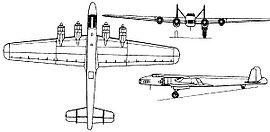Dornier Do 19 Video - Picture

|
|
Dornier Do 19
Do 19
Manufacturer: Dornier-Werke GmbH
First flight: October 28, 1936
Status: Canceled
Primary user: Luftwaffe
Number built: 3
The Dornier Do 19 was a German four-engine heavy bomber that first flew on October 28, 1936. Only one prototype flew, and it was converted to a transport in 1938. The other two were scrapped.
The Luftwaffe had a shortcoming in the lack of an efficient heavy bomber fleet. Generalleutnant Walther Wever, the Luftwaffe's first Chief of Staff was the most persistent advocate of a German long-range strategic bomber fleet. It was built for the Luftwaffe's Ural bomber program under General Walther Wever. The RLM Technisch Amt issued a specification for a four-engine heavy bomber. But after Wever's death in an airplane crash in June 1936, Wever's successor, Albert Kesselring, canceled Germany's long-range bomber projects to concentrate on tactical bombers.
Both Dornier and Junkers were competitors for the contract, and each received an order for three prototypes in late 1935. The Dornier design was given the project number of Do.19, while the Junkers prototype became the Ju 89.
History & Development
The Dornier Do 19 was a mid-wing cantilever design, and was mostly metal in construction. It had a rectangular-section fuselage and a tail unit, quite similar to the one fitted to the contemporary British Armstrong Whitworth Whitley medium bomber, with braced twin fins and rudders, mounted on the upper surface of the tailplane. It also had retractable landing gear, including the tail wheel. The power plant, according to some sources, was supposed to be four Bramo 322H-2 radial engines that were mounted in nacelles at the leading edges of the wings.
It had a crew of nine, which would have consisted of a pilot, co-pilot, navigator, bombardier, radio operator and five gunners. The V1 prototype flew on 28 October 1936. After Generalleutnant Wever died in an airplane crash, the heavy bomber program lost its momentum, and never recovered. When the Luftwaffe was given its heavy blow over the skies of England, the error of not having heavy bombers became apparent. But by then, it was too late in the day to develop the bombers required.
Albert Kesselring, Wever's successor, believed that what Germany required was more fighters and tactical bombers. Therefore the V2 and V3 prototypes were scrapped. The original V1 became a transport in 1938. The Dornier Do 19 was only built in prototype form, yet it had a promising design that could have yielded a useful long-range bomber.
Specifications (Do 19 V2)

Picture - Dornier Do-19 Technical Specs.
General characteristics
Crew: ten, pilot, co-pilot, navigator, bombardier, radio operator and five gunners
Length: 25.4 m (83 ft 6 in)
Wingspan: 35.00 m (114 ft 10 in)
Height: 5.77 m (19 ft)
Wing area: 162 m² (1,744 ft²)
Empty weight: 11,865 kg (26,158 lb)
Loaded weight: 18,500 kg (40,785 lb)
Powerplant: 4x— BMW 132F radial engine, 604 kW (810 hp) each
Performance
Maximum speed: 315 km/h (196 mph)
Range: 1,600 km (994 mi)
Service ceiling: 5,600 m (18,370 ft)
Wing loading: 114 kg/m² (23 lb/ft²)
Power/mass: 0.13 kW/kg (0.08 hp/lb)
Armament
1 x— 7.92 mm (.312 in) MG 15 machine gun in nose
1 x— 7.92 mm (.312 in) MG 15 machine gun in tail
1 x— 20 mm cannon in dorsal turret
1 x— 20 mm cannon in ventral turret
16 x— 100 kg (220 lb) bombs
Comparable aircraft
Ju 89
Heinkel He 277
Heinkel He 274
Dornier Do 19 Pictures
More aircraft.
Source: WikiPedia